|
The guiding metaphor for understanding discipleship is the process Jesus used. He walked with his disciples, teaching them and showing them what he wanted them to become and to do in this world. The story of the Road to Emmaus in Luke chapter 24 depicts what this process looks like. The story begins with Jesus “coming up and walking along with them” (v.15). Jesus makes contact yet the disciples “did not recognize him.” Jesus connected with them by asking questions (v17, 19, 26), digging into their experiences and helping them see what they couldn’t yet perceive (v27). This kind of connection is made in the internal struggle in which they could not understand what Jesus was teaching them. When they arrived at the village, they offered Jesus a place to stay. Jesus committed to joining them for a meal. Here at the table, Jesus shared a regular meal in the same ritual format - becoming a covenant meal as the Eucharist by taking the bread, giving thanks, breaking it, and giving it to them (v31). It was at this moment the disciples recognized Jesus who had been walking with them all along. Make Contact > Make Connection > Make Commitments > Make Covenant The rubric for pastoral engagement evaluates the work of the pastor, not who the pastor is trying to reach or who is more committed to his or her work. When it comes to evaluating oneself as a pastor, many times it is the other person’s behavior being measured and held accountable whether it’s a student or employee or church member. In the case of pastoral ministry, the tables will be turned and instead measure the pastor for evaluation. How can the pastor tell if he or she is doing well?
What is missing from other evaluative tools for making disciples, such as church attendance, sermon series, and giving records, is found in what do pastors do and how do they know they’re doing it well. If there is a way to understand and evaluate the work of the pastor, this is how to do it: make contacts, recognize connections, engage in commitment to participate in their lives and work, and recognize covenant partnership with them as members of the Body of Christ. This is the pathway of making disciples in a way that Jesus did. Sample rubrics: Contacts Pastor How-to Habit #1 -- Initiate eight new contacts every month. That’s 96 new contacts in a year. Connection Pastor How-to Habit #2: Twice a month celebrate a new Kingdom work in someone’s life or with the community through the work of the church during the main service; and twice a month promote new opportunities to serve in the church and in the community. Commitment Pastor How-to Habit #3 - Select four activities outside of church that are important for some of those in your community of faith, e.g. sports league participation, workplace volunteer. Use your time in these spaces to get to know this part of your parishioners’ lives outside of their participation in church. Get to know their friends, family, and colleagues especially those not already part of your congregation. Commit to being involved in these four activities for at least four months. Covenant Pastor How-to Habit #4 - Choose up to twelve parishioners that seek a deeper experience with Christ and walk with them in a more intimate fellowship. Pray for them, but also ask them to pray for you. Teach them from what you’re reading. Ask them what they are learning and let them teach you. A covenant is mutual and multi-directional. Agree to meet regularly even weekly for up to one to three years.
13 Comments
I’ve heard folks in my denomination talk about “high impact churches.” It's a phrase that's been out there for a few years, in particular an eponymous book by Linus Morris. His primary shift is thinking about church not so much as being situated in a geographic location but within large scale social network. This move was important a quarter of a century ago when Morris published with the rise of the internet and globalization. I think we've seen a cultural migration away from dislocation as a norm toward place-centered living. Anecdotally, people just are not transient as they used to be. People tend to grow where they are planted. The trend is playing out during the last year. If people are moving, it is close to where they already are:
"This local movement means that even for residents who did move further from an urban center, many remained part of the same regional economy. And most of those who moved further afield tended to stay within a radius of 100 to 150 miles."- "More Americans Are Leaving Cities But Don't Call It an Urban Exodus" - Bloomberg News, April 26, 2021 The "same regional economy" is the same as a megaregion, which I written about elsewhere on this blog. People are moving but staying within a place called home. So, one's social network is the same as sharing a place: familiarity in particularity. My denomination leans toward defining high impact churches as those that start with a large core of attenders, around 200 (multiplynaz.org). These kinds of churches are also actively working toward getting people involved in the life of the church, usually through a system of discipleship groups. Much of the focus is building internal capacity for nourishing the faithful and reaching the like-minded. It's a consumer-driven approach to building the church. I was never really satisfied with these notions of what church should look. The cynical side of me thinks that the emphasis is on HYPE -- just trying to get people in the door and find ways to keep them around. The non-cynical side of me wonders if evangelism of attraction will actually lead toward discipleship: the true calling of the church is to make disciples. In 2020, I read an article on 11 Traits of Churches That Will Impact the Future by Carey Nieuwhof that fleshed out what I think I mean by “high impact churches.” Nieuwhof wrote this article in 2013. It could easily have been written yesterday. It has given structure to what a high impact church might look like. Nieuwhof’s thoughts on what these kinds of things that could be considered high impact churches bear repeating: “When you learn to say no to the preferences of some current members, you learn to say yes to a community that is ready to be reached.” “If you can’t make a decision within 24 hours, your process is too slow.” “In fact, more and more larger churches will start embracing smaller venues, locations and partnerships to keep growing. A great number of smaller venues might be a hallmark of future churches making an impact.” “Get innovative and start looking at portable and non-traditional ways of growing your ministry.” “Churches that understand that embracing questions is as important as providing immediate answers will make an impact.” “Churches in decline often think in terms of what they can get from people - money, time, growth, etc.” “Churches that decide they will hold the message sacred but tailor the experience to an ever shifting culture will be more effective.” From Nieuwhof’s article, I narrowed my emphasis on eight aspects of high impact churches. When I see these concepts at work in a church, there’s a good chance they are making an impact on their community. These practices are not based on church size or financial capacity. I believe all of these descriptors need to be present for a local church to be considered a high impact church. If they are not all present, then these aspects become aspirations for what a church seeks to become in its community. outsider focus Overview: Understands local context, knows the map, makes strangers into friends Questions toward becoming outsider focused: --Who lives in your neighborhood? --What contribution does your church make to this neighborhood? --Do they know your name? Do you know theirs? --Do they invite you to participate in their lives? partnership plan Overview: Realizes they cannot go it alone, becomes connectional, seeks district oversight and guidance, leans on a prayer network, looks for local sources of funding, enters into a larger global family Questions toward building a partnership plan: --What organizations are doing what you think the church can/should be doing? --How are you helping them do this work? --What gifts does your church have to offer these organizations? --If there is not an organization doing this work, how can your church start doing it? leadership team Overview: Rule of Four in team leadership, each position is a function, response-ability, self-perpetuating Questions toward pulling together a leadership team: --Who are the four people that are always there that dream big and make things happen? --Who needs to be involved in the decision-making --What are examples of tangible and memorable evidence of the trust that has been built between these leaders and the rest of the church? adaptable ministry Overview: No canoes (Tod Bolsinger), learns to say no to insiders to include outsiders, cultural shifts, does what is necessary, focused on a few ministries, inter-culturally sensitive Questions toward implementing adaptable ministry: --How quickly can a ministry be started in church for the community? --What is the ratio of active volunteers to regular church attenders? --Where can be found written expectations for volunteers? --How often is training held for new volunteers? --What kind of gratitude is shown to volunteers? --What are active ways the church reaches out to the marginalized - not like the majority of those already in the church? --How are different languages and cultures from your community represented in your church? flexible footprint Overview: Little overhead, just in time planning, ready to move, costs in people. “Get innovative and start looking at portable and non-traditional ways of growing your ministry.” Questions toward having a flexible footprint: --Who decides when a new ministry might begin? Or when it might end? --How many “circles” or smaller groups of church folks meet outside of regular worship gatherings? --Where are there places to meet for church folks to meet together beyond gatherings at church? discipling culture Overview: Multiple avenues, everyone involved, participatory, movement toward everyone discipling someone else Questions toward a discipling culture: --What is the next step for a new believer in your church? --How are these next steps communicated to new believers? --How many members have actively taken part in making new disciples in the past year? --What is considered essential knowledge and practice for disciples in your church? --Who or what criteria in your local church determine what is essential for making disciples? --What does this pathway of disciple look like in your church? online presence Overview: Social presence, connectivity: “Sure, face to face is deeper, but people will tell you things online they can’t muster the courage to tell you face-to-face.” Questions toward creating an online presence: --Does your church have a website or Facebook page that is updated on a weekly basis? --What are ways for someone to participate in a worship service or discipleship group even though they are online? --What are ways people can be engaged via message or comment boards in an online environment? --Who tracks online involvement in your church? --What online resources available for discipleship opportunities, financial giving, registering for events or ministry sign-ups? --In what ways will someone be able to find out what is happening at your church this month by going to the website? citywide engagement Overview: Planted to grow here not there, able to engage a transient society, has social awareness, recognizes their place in society, stones in a stream Questions toward engaging the whole city: --In what ways does your church provide avenues to connect to the larger community around the church? --How does the church find ways to meet with or partner with other churches even if it is just with other church pastors? --How does the church offer its voice to concerns within the larger church community? --What markers in the church’s building, signage, website, and events that show evidence of its community’s presence? --Where do people live that regularly attend, participate or have a connection to the church? “give not get” mentality Overview: Asks what the church can do for you not to what it can get from you : “Church that will make an impact on the future will be passionate about what they want for people - financial balance, generosity, the joy of serving, better families, and of course, Christ at the center of everyone’s life.” --What is the church doing for its community without any strings attached or return on investment? N.T. Wright is offering a course that "have meant the most to [his] spiritual development." And, so, I began reflecting on what passages from. the Scriptures have shaped me. I'm not a fan of "life verses." They seem more like bumper stickers of wisdom extracted from their source and surroundings. The interest here is to get to the passages that have continually drawn us back over the years. I cannot really shake what they tell me about myself and the world I wish to inhabit. Here is the beginning of my list: Romans 1:16-17 NIV "For I am not ashamed of the gospel, because it is the power of God that brings salvation to everyone who believes: first to the Jew, then to the Gentile. For in the gospel the righteousness of God is revealed—a righteousness that is by faith from first to last, just as it is written: 'The righteous will live by faith.'” It's really verse 16 that jarred me loose. I was a new believer, at a youth retreat for the South Central Ohio District in Ripley, West Virginia. The speaker talked about this verse. It was later in the weekend that I sensed a calling to mission and ministry. So, I've always taken to heart the desire to not only be with those inside the group but also to be among the outsiders. This is really the verse that brings to life the whole notion of the doctrine of entire sanctification--"the power of God that brings salvation to everyone who believes" either it works for everyone or no one. One of the few either/or's in my spiritual lexicon. Colossians 3:1-14 NIV "Since, then, you have been raised with Christ, set your hearts on things above, where Christ is, seated at the right hand of God. Set your minds on things above, not on earthly things. For you died, and your life is now hidden with Christ in God. When Christ, who is your life, appears, then you also will appear with him in glory. "Put to death, therefore, whatever belongs to your earthly nature: sexual immorality, impurity, lust, evil desires and greed, which is idolatry. Because of these, the wrath of God is coming. You used to walk in these ways, in the life you once lived. But now you must also rid yourselves of all such things as these: anger, rage, malice, slander, and filthy language from your lips. Do not lie to each other, since you have taken off your old self with its practices and have put on the new self, which is being renewed in knowledge in the image of its Creator. Here there is no Gentile or Jew, circumcised or uncircumcised, barbarian, Scythian, slave or free, but Christ is all, and is in all. "Therefore, as God’s chosen people, holy and dearly loved, clothe yourselves with compassion, kindness, humility, gentleness and patience. Bear with each other and forgive one another if any of you has a grievance against someone. Forgive as the Lord forgave you. And over all these virtues put on love, which binds them all together in perfect unity." My first sermon in French was on this passage. It's just packed with the basics of Christian theology on the Incarnation - the heavenly becomes earthly - as well as the transformative power of the Resurrection that continually brings about a newness to daily life - la vie quotidienne. Even the mundane gets an overhaul. Especially the mundane, daily, boring makings of a life become something glorious in the hands of God. Moving toward Christlikeness makes us more like Christ and more recognizable to each other: "Here there is no Gentile or Jew, circumcised or uncircumcised, barbarian, Scythian, slave or free, but Christ is all, and is in all." This is not only an individual transformation but it is witnessed in the whole of "God's chosen people, holy and dearly loved." The witness continues through the people as they "bear with", "forgive", "love" and all the one anothers that "binds them all together." They surely don't look alike but they are "unified" in the Body and Blood of Christ--here on earth as it is in heaven. I'll continue the list over the next few weeks, this is just a beginning. The COVID-19 pandemic has made it difficult to for groups of people to gather. For the church, weekly worship gatherings have become nearly impossible or restricted by local guidelines. It is possible for the local church to be present in its context but it may require becoming a network of house churches. Here are links to a Powerpoint presentation and training video followed by a print version of the training material. 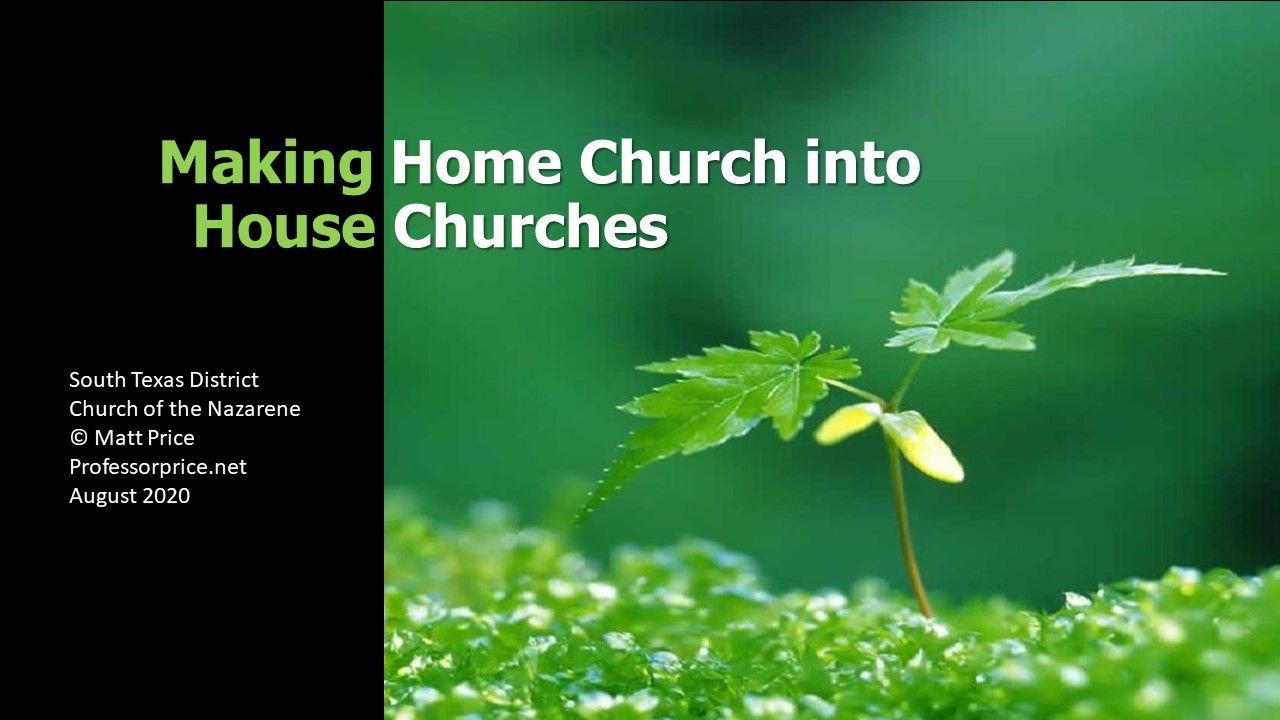 (Click image to download presentation slides) (Click image to download presentation slides) Church, Defined The church is still the church regardless of how it gathers. One definition of church is defined is: “Any group that meets regularly for spiritual nurture, worship, or instruction, with an identified leader and aligned with the message and mission of the Church of the Nazarene, may be recognized as a church and reported as such for district and general church statistics.” Board of General Superintendents, December 8, 2015 There are five minimum characteristics for a local church to be a church. “Any group that (1) meets regularly for (2) spiritual nurture, worship, or instruction, (3) with an identified leader and (4) aligned with the message and mission of the Church of the Nazarene, (5) may be recognized as a church and reported as such for district and general church statistics.” Let's compare a description of the New Testament church from the Book of Acts to the five characteristics of a local church: Acts 2:42-47 (NRSV) compared to BGS ruling 2015 42 They devoted themselves [meets regularly] to the apostles’ teaching [identified leader] and fellowship, to the breaking of bread and the prayers [spiritual nurture, worship, instruction]. 43 Awe came upon everyone, because many wonders and signs were being done by the apostles. [Identified leaders] 44 All who believed were together and had all things in common; 45 they would sell their possessions and goods and distribute the proceeds to all, as any had need. [aligned with the message and the mission] 46 Day by day, as they spent much time together in the temple, they broke bread at home and ate their food with glad and generous hearts, [recognized as a church] 47 praising God and having the goodwill of all the people. And day by day the Lord added to their number those who were being saved. [reported as such for district and general church statistics] (thanks to John DeMuth for thinking this through with me) There are right and wrong ways of meeting as house churches, according to church planter Steve Brenmer (2012). What house churches do right: Intimacy, accountability, offers freedom and flexibility, outward-focused (with an emphasis on reaching neighbors, and meets with intentionality (know why they are doing what they’re doing). What house churches do wrong: Still needs physical space to meet, turns inward-focused, no longer brings in new people, no longer makes disciples and just hangs out, becomes arrogant in that this smaller gathering is the only legitimate way to meet together as the church. How are house churches different than small groups? Small groups are focused on one thing: fellowship, Bible study, gender groups, or a service project. House Churches are focused on being the church: worshipping, learning, serving as an extension of the Body of believers gathered together Where should house churches meet? Geography - ZIP code, housing development, apartment complexes, direction from the gathered church Why geography? Same schools, same grocery stores, travel time, needs to be a focus on gathering for being the church not around lesser reasons, Keep the purpose in focus Why not affinity groups or groups of friends? See the point about house churches being inwardly focused. Rarely will this kind of group invite an outsider that isn’t already closely connected to someone in the group. This group also is so focused on the ancillary reason they are meeting together, such as a book club or women’s group, and not why they are meeting together as the church. Make the Body local. Find where the Body already is. Let the Church move into the neighborhood. Who meets in the house church? Around ten adults. Jewish synagogues require at least ten heads of household. The same applies here. A church of 50 might have two churches of 18 to 25 people or three groups of 15 to 18 people. Those involved in house church include: The designated (trained) leader appointed by the pastor/board as a lay preacher, the host family, children/youth activity volunteer, and any other guests. For COVID-19 precautions - Suggest no more than 10 persons at a time in a room or backyard gathering. Children might go right into a lesson time in a separate space rather than gather with the whole to limit numbers in a single space at one time. Masks recommended (and may be required by the host family). Remember that everyone is a guest. Household rules need to be honored by the guests When does a house church meet? Options include:
Suggested time frame is 90 minutes from arrival of guests to departure of the last family Example: 4:30 p.m. Arrive at the location 4:45 p.m. Begin the time together whether it is singing together or sharing praises with one another, including listening to the worship portion of morning’s service, listening/singing along with a Spotify playlist, etc.), lead by a single guitar or piano, no more than three songs 5:00 p.m. Announcements and allow children’s and youth activities to begin in other rooms 5:05 p.m. Listen to the sermon together. Feel free to pause for discussion 5:30 p.m. Pause for response, accountability, and prayer. Feel free to make smaller groups for prayer if space allows. 5:45 p.m. Gather for snacks, finger foods, and fellowship 6:00 p.m. Begin departing More COVID-19 precautions - Consider not serving food. Limit the gathering time to 45 minute to avoid the need for restroom usage.Also, singing may not be wise in a small, confined space. Other options include someone playing an instrumental or ensemble together, reciting a poem, memorizing and reading hymns together interspersed with prayer, Bible reading and reflection (e.g. lectio divina). How does the house church stay connected to the primary local church? The designated leaders are trained, accountable to, and appointed by the pastor and staff. A local church board might confer a local minister's license to each house church leader. Designated leaders report the meeting times in advance and accurately to the pastor and church staff for promotion on the web site or social media. House Church leaders also track and report participation in the house church. They are also responsible for giving prayer requests and concerns to the pastor and church staff. Offerings are best handled through online giving opportunities. If cash and checks are given, designated leaders are to bring to the pastor and/or church office the following day. Or, mobilize the finance team/board members to collect the offerings and bring to the church office for accounting and deposit. The pastor and/or church staff may distribute announcements (written copies or weblinks to online videos), as well as give leaders the weekly discussion questions for the sermon/teaching times, and share prayer requests. Host families may display a yard sign showing connection to the primary church with contact info, websites, and maybe leaflets with take-home information. Board members could be asked to host or attend the house church gathering nearest them. One or two board members could volunteer to visit multiple house church gatherings as a means of accountability. What makes this “count” as going to church? The BGS definition of church as gathering for “spiritual nurture, worship, or instruction” is consistent with the message and mission of the Church of the Nazarene whether the gathering is in a church building, in a house, or anywhere else. There will be three essential elements in every gathering (borrowing language from Neil Cole):
How can house churches still feel unified as to the local church?
This morning I presented a training session on posmodern evangelism to over twenty church leaders from across the United States and from Kenya. The hope is to be humble enough to listen, draw near, and engage people in conversation along the journey toward Christ--the trajectory of grace through the threshold of faith. Below is the downloadable powerpoint file. Later, I will be able to link to a video of the training session. Thanks to Black Dog Coffeeshop in Lenexa, Kansas for providing the necessary caffeine for an early Saturday morning. And, to the Lord, for pointing us all toward the Life we all seek. Link to the video file on dropbox: CLICK HERE
"The biblical tradition reveals that whenever the prophetic gift is lacking in any group or religion, such a group will very soon be self-serving, self-perpetuating, and self-promoting. Without prophetic criticism, all sense of mission and message is lost. Establishments of any kind usually move toward their own self-perpetuation, rather than 'What are we doing for the world?' In fact, the question of mission is not even asked because self-perpetuation has become an end in itself."
- Richard Rohr, Daily Meditations 2018 About one-fourth of the churches in the Front Range megaregion are designated as ethnic. Only 15 have assigned pastors; one is in a dual charge assignment. Two of the 15 assigned pastors are women. Twelve percent have more than 75 in average worship attendance. One out of every ten Nazarene members on this megaregion belongs to an ethnic church. The predominant ethnicity is Hispanic. ResourcesThere are six female Nazarene senior assigned pastors in the Front Range megaregion. That's 8% of the senior assigned pastors here. The largest church attendance with a female pastor is 92; however, the median attendance is 25. Two-thirds of the women have served in their current assignment for less than eight years. It seems as if there is going to be enough churches to reach the coming population expansion in this megaregion, women seeking ministry will have to be sought, encouraged, and nurtured into ministry just as much as men. There is a clear emphasis on male leadership when there honestly may not be enough men available or responding to the call to preach. Whatever may be the case, where are the women and who will open doors, clear the pathway, and become mentors for them? What would it take for a current pastor to mentor more women into ministry? ResourcesThere are 75 senior assigned pastors on this megaregion, one pastor has a dual assignment in two churches. There are 17 churches without an assigned pastor. The median tenure for pastors on this megaregion is 2012. That means half of the pastors have been in their current assignment since this date. One-third of these pastors have been in their assignments for less than four years, and another one-third for more than eight years. Eighteen pastors have been in their assignments for more than a decade. Median worship attendance at churches with an assigned pastor is 57. This is for a population of 5.5 million (see second image below). This megaregion will add another 4.8 million people in the next three decades. If the current number of pastors (75) is maintained during the population growth that will occur, the following ratios apply: One pastor for 73,333 people (2010) One pastor for 92,000 people (2025) One pastor for 136,000 people (2050) ResourcesThe Front Range megaregion includes the urbanization along the eastside of the Rockies from Cheyenne in the north toward Albuquerque in the south. I have extended the megaregion's territory further south to El Paso, Texas following the Rio Grande River. This megaregion also includes the urban island of the Salt Lake city metro area in Utah. The megaregion is very similar to the elongated megaregions of the Gulf Coast and Arizona Sun in that they intermingle or overlap the Mexican border. Again, national and state borders do not always show separation between where people choose to live, work, and do business. These kinds of borders also have very little to do with how people come to Christ and choose to gather for church fellowship. The missional impulse flows from where people gather. The Front Range megaregion is smaller than most of the other megaregions with just over 5 million people. It will also double in size in the next thirty years to over 10 million inhabitants. There have been just over two hundred Nazarene churches (209) started or organized in this megaregion. Of these churches, 93 are still active. The previous two decades have been the most proliferate with 39 churches started or organized. By comparison, 42 churches were started or organized between 1970 to 1999. The oldest active churches are the First Churches of Salt Lake City and Denver, started in 1903 and 1907, respectively. There are five churches over 100 years old on this megaregion. Over the course of time, there have been 116 churches closed from the 209 that have been started or organized. The year with the most closings was 2002. No other year had double digit closings. Notably, over half of all churches that have been closed were closed since 2000 (53%). The spike in closings can be easily seen in the chart on the infograph below. Fourteen churches (14) closed after fifty years of active ministry. The rate of churches closing within two years, seven years, and twelve years remains consistent. Just shy of one-fifth of churches closed within two years, almost half after seven years, and six out of ten churches closed within twelve years. Churches Closed . . . 18% within two years 44% within seven years 69% within twelve years Resources |
Bio
teacher, writer, Archives
August 2022
Categories
All
|
||||||||

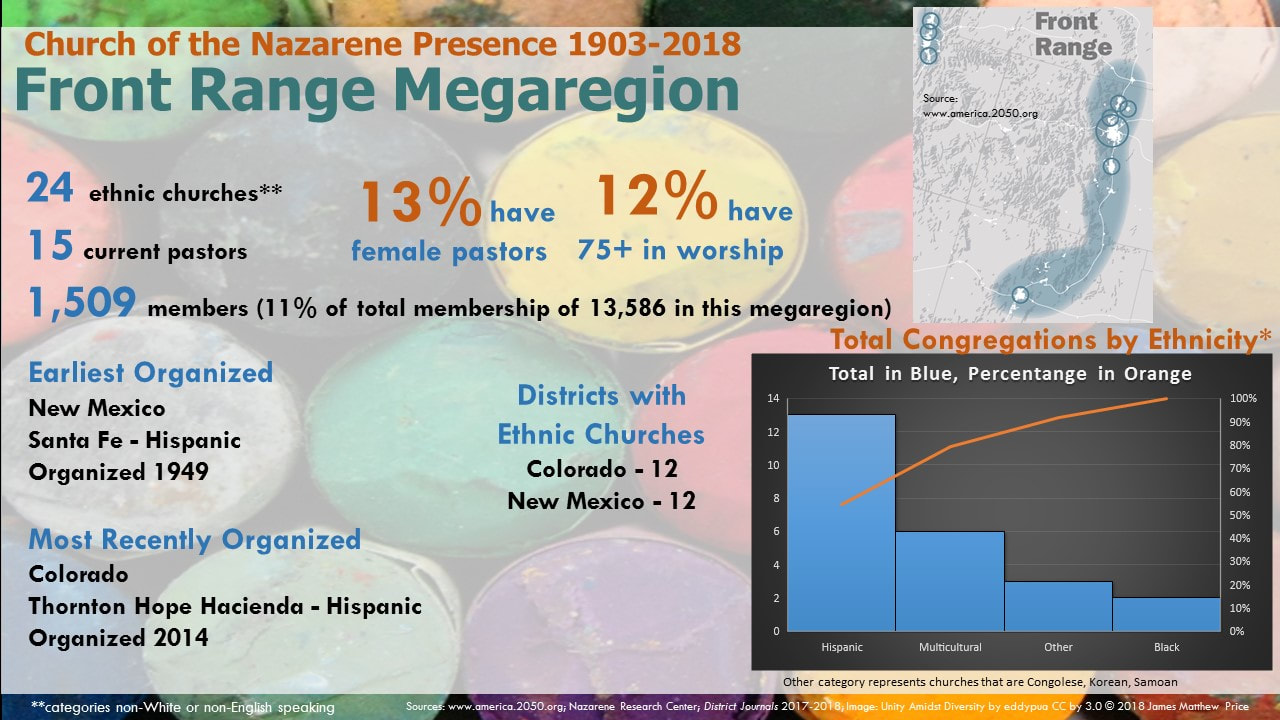
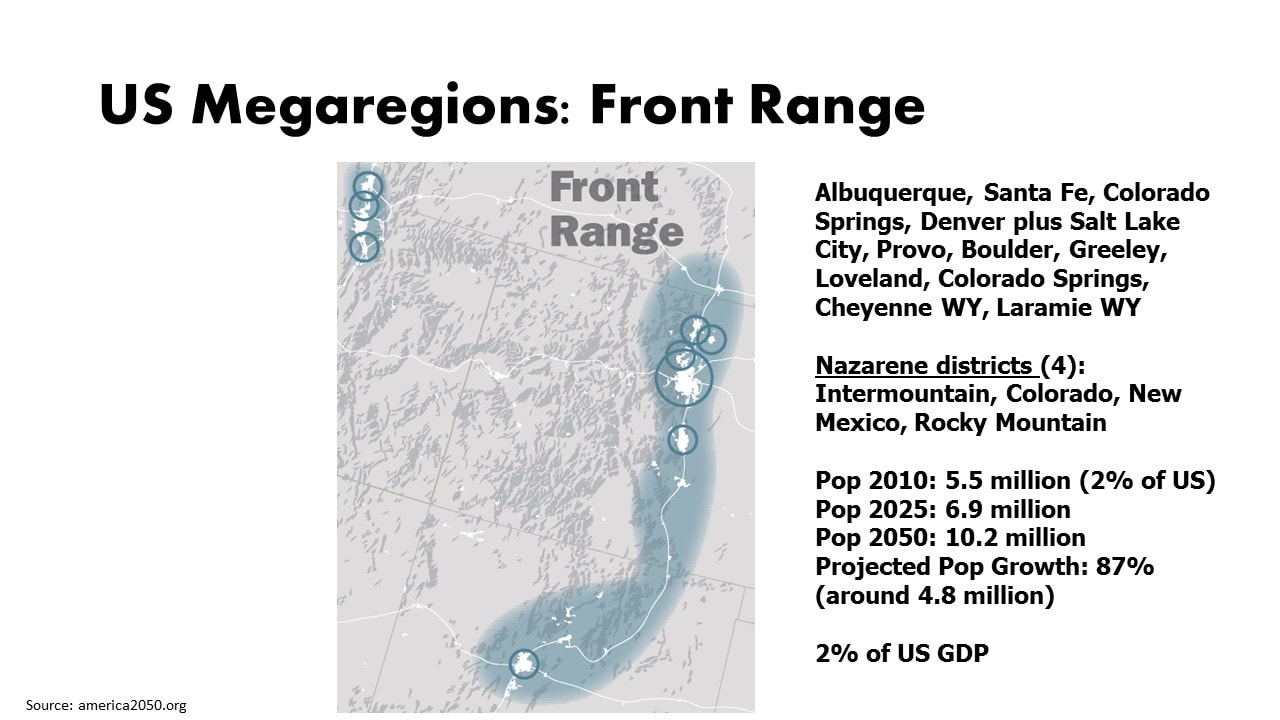
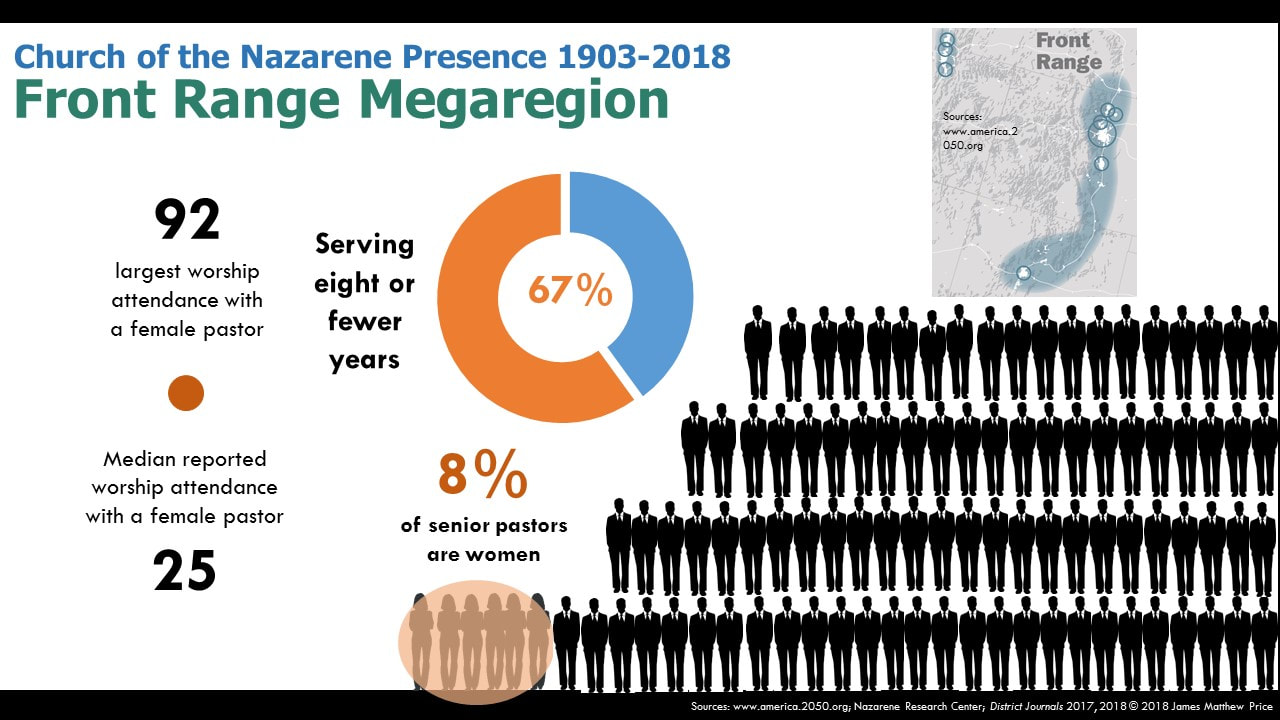
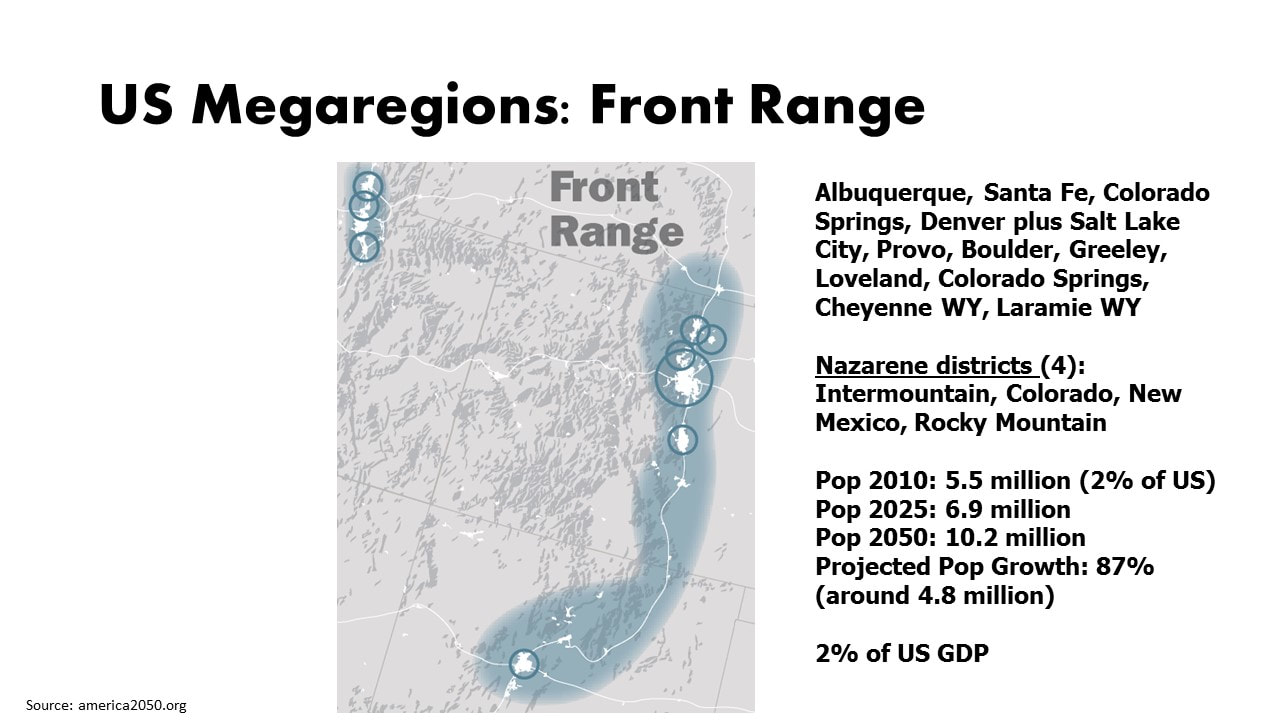
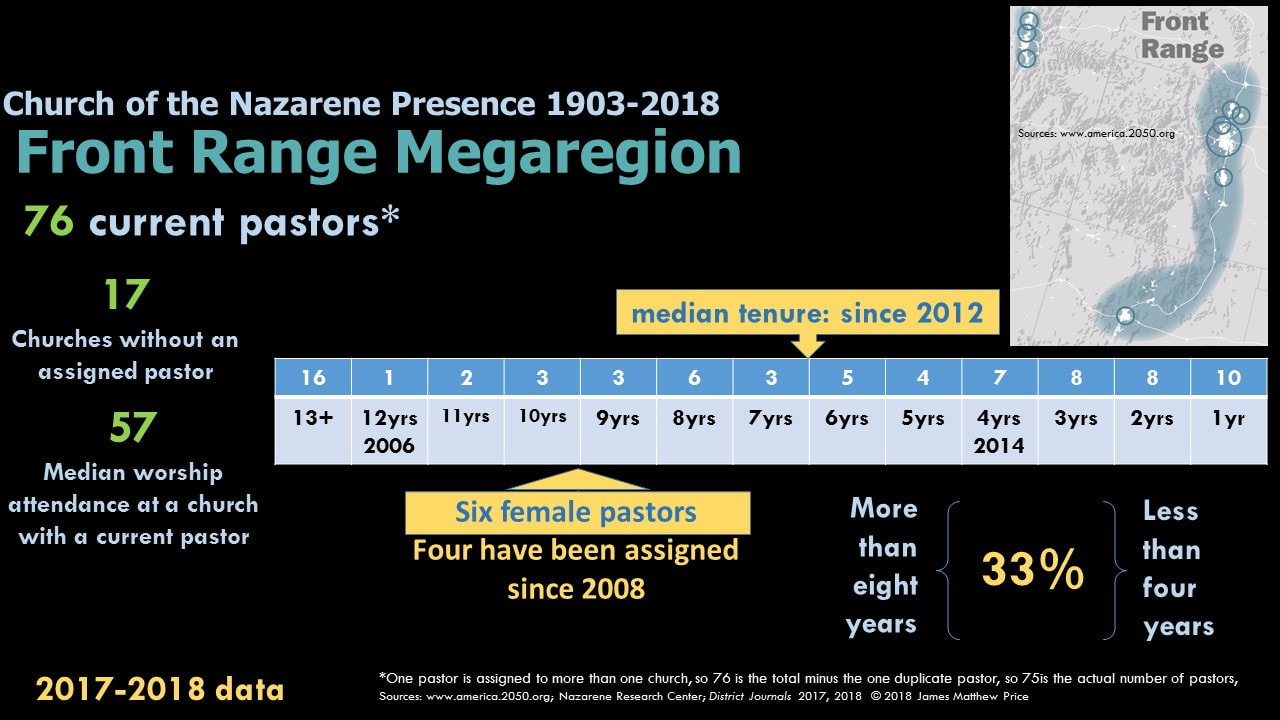
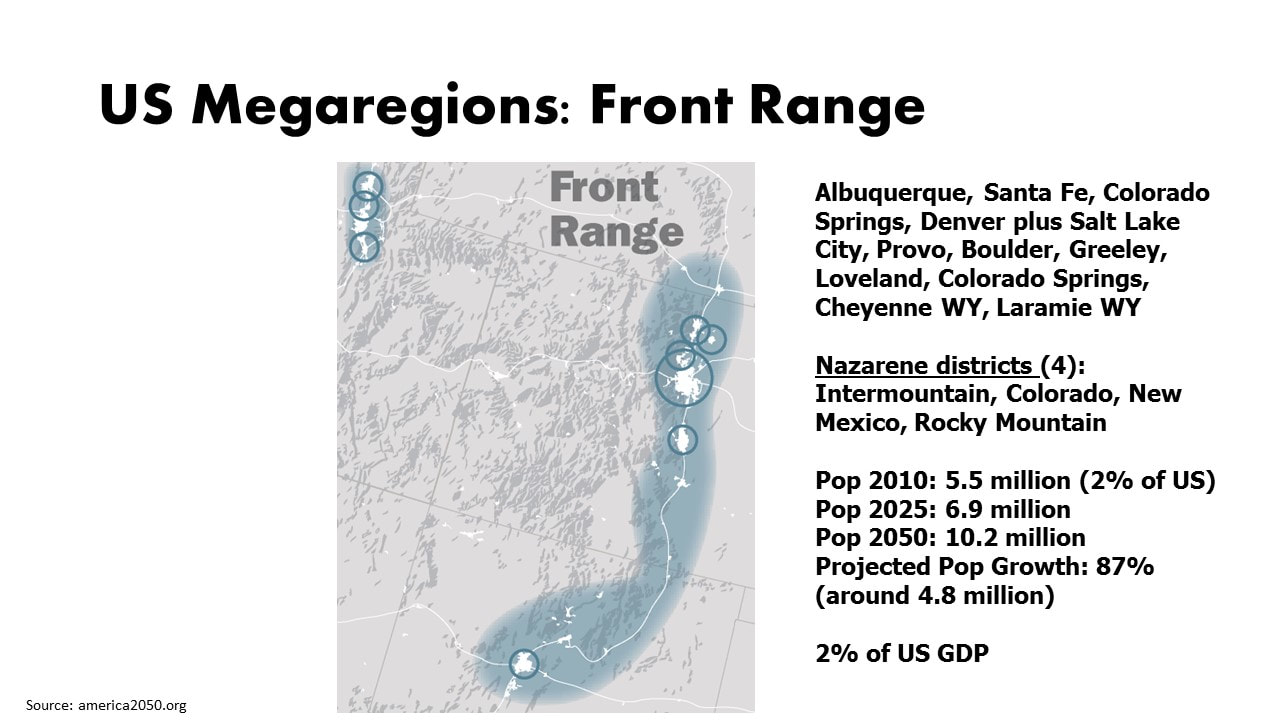
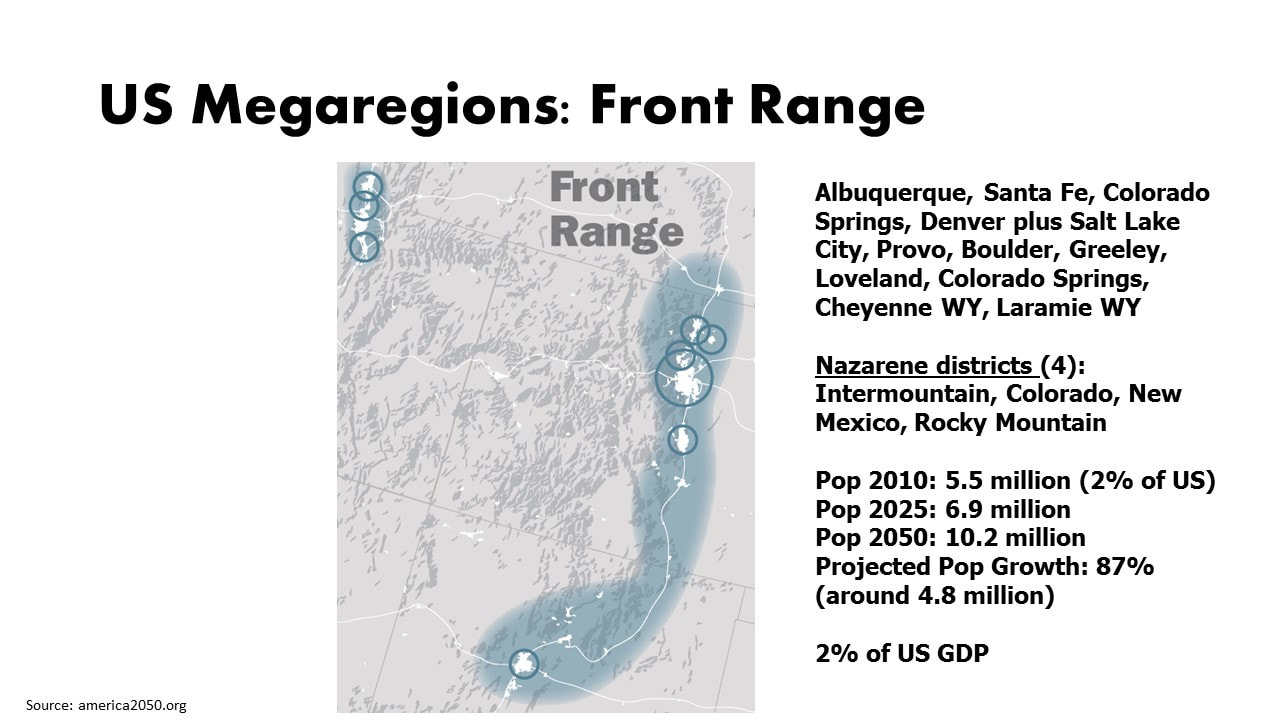
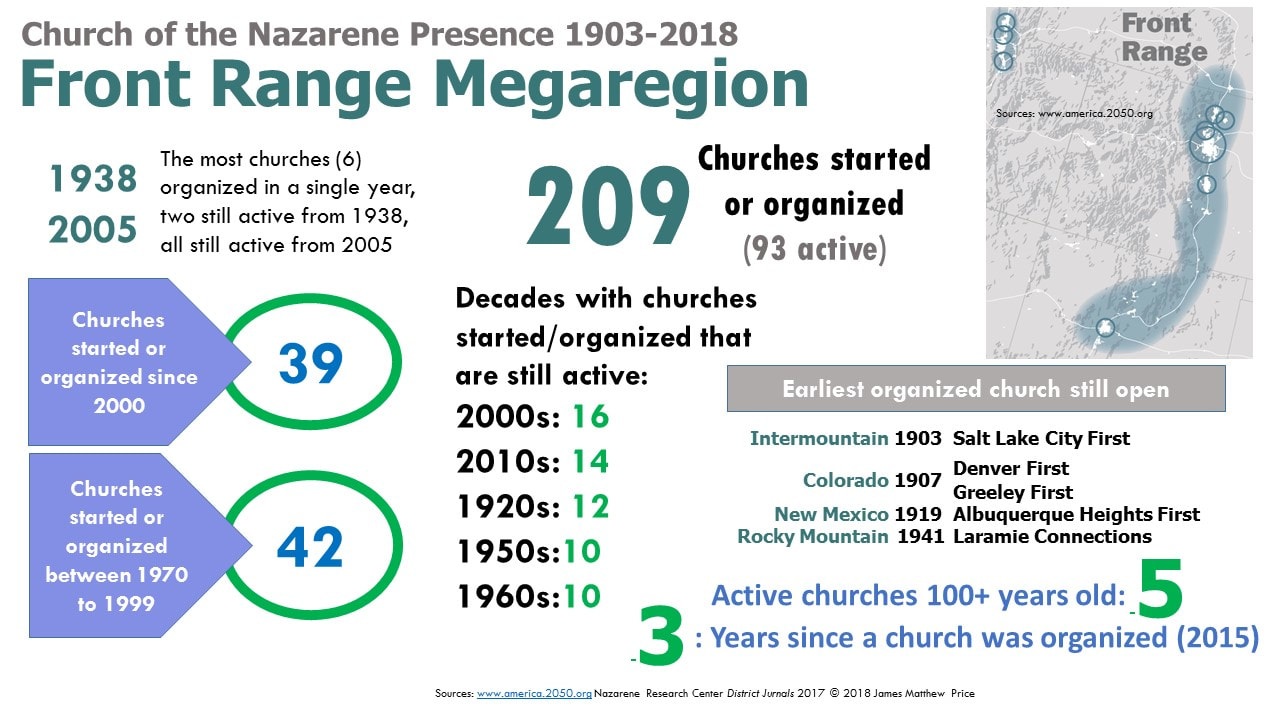
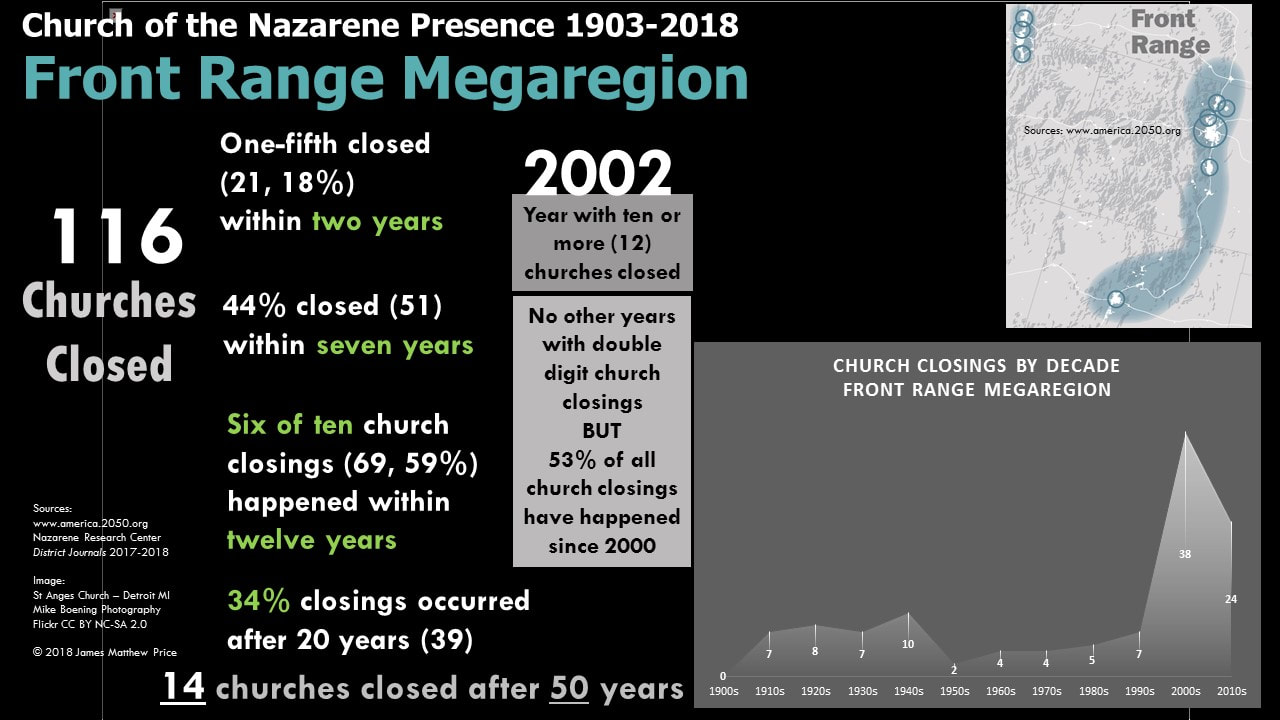

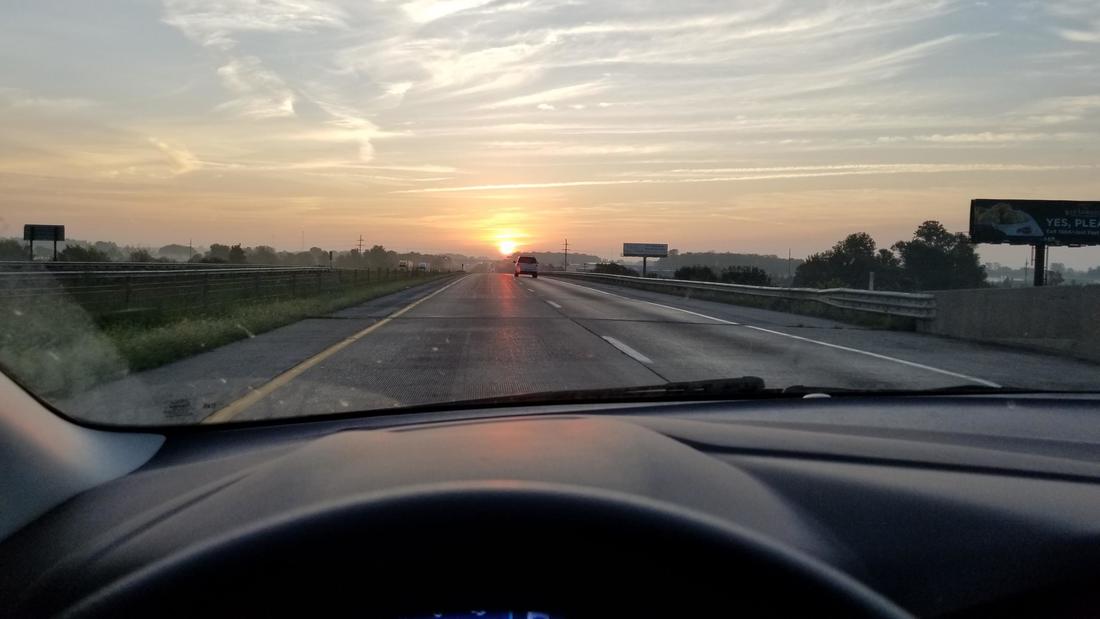

 RSS Feed
RSS Feed